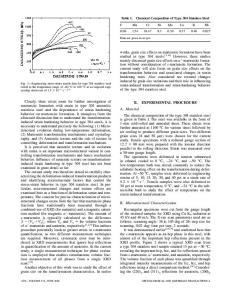Ultrasonic Characterization of Strain Hardening Behavior in AISI 316L Austenitic Stainless Steel
- PDF / 422,604 Bytes
- 5 Pages / 593.972 x 792 pts Page_size
- 81 Downloads / 310 Views
ent years, ultrasonic velocity measurement has been used increasingly as a nondestructive technique to study various characteristics and processes of materials. Several investigations have been performed to correlate velocity measurements with the microstructural features,[1–3] physical properties,[4] mechanical properties,[5–7] heat treatments,[8–10] grain size,[11] and the amount of deformation.[12–14] However, the correlation between strain hardening behavior and ultrasonic velocity, especially in low stacking fault energy (SFE) alloys, has not received attention so far. The strain hardening technique is widely used for strengthening the metallic components. From a technological viewpoint, an accurate characterization of strain hardening behavior of a material is necessary to develop models with good predictive capabilities concerning the force–displacement relationship in deformation P. BEHJATI, Research Scholar, A. NAJAFIZADEH, Professor, H. VAHID DASTJERDI, M.Sc. Graduate, and R. MAHDAVI, B.Sc. Graduate, are with the Department of Materials Engineering, Isfahan University of Technology, Isfahan 84156-83111, Iran. Contact e-mail: [email protected] Manuscript submitted May 7, 2010. Article published online December 15, 2010 METALLURGICAL AND MATERIALS TRANSACTIONS A
processes. In addition, it provides clear indications of the beginning or collapse of many of the microstructural phenomena occurring during deformation. A transmission electron microscope (TEM) and an optical microscope (OM) usually are applied to characterize the strain hardening behavior of materials; however, sample preparation for these techniques is difficult and time consuming. Also, in a recent study, it has been shown that the deformation mechanism of SFE alloys cannot be characterized solely by OM.[15] Strain hardening behavior of low SFE face-centeredcubic (fcc) alloys (such as Hadfield steels, austenitic stainless steels, and multiple Co-Ni superalloys) have been studied extensively.[16–19] It is known that the strain hardening rate (h)–true strain (e) plots of these alloys exhibit four distinct regimes of hardening. In stage A, the strain hardening rate decreases continuously with deformation. This stage is followed by a second stage of nearly constant hardening rate, stage B. The second falling regime of strain hardening is observed in stage C. At large strains, this stage is interrupted by a second, nearly constant hardening rate (stage D). Asgari et al.[16] studied the microstructural phenomena occurring during the various stages of strain hardening in low SFE fcc alloys under large deformations. Their results suggested that the fall in the hardening rate during stage A is a result of the occurrence of cross slip. The formation of primary deformation twins was responsible for the onset of stage B. Stage C was correlated with a decreased rate of primary twins formation because of (1) the development of severe inhomogeneity of deformation within most grains and (2) the loss of matrix–twin interface coherency with continued def
Data Loading...











